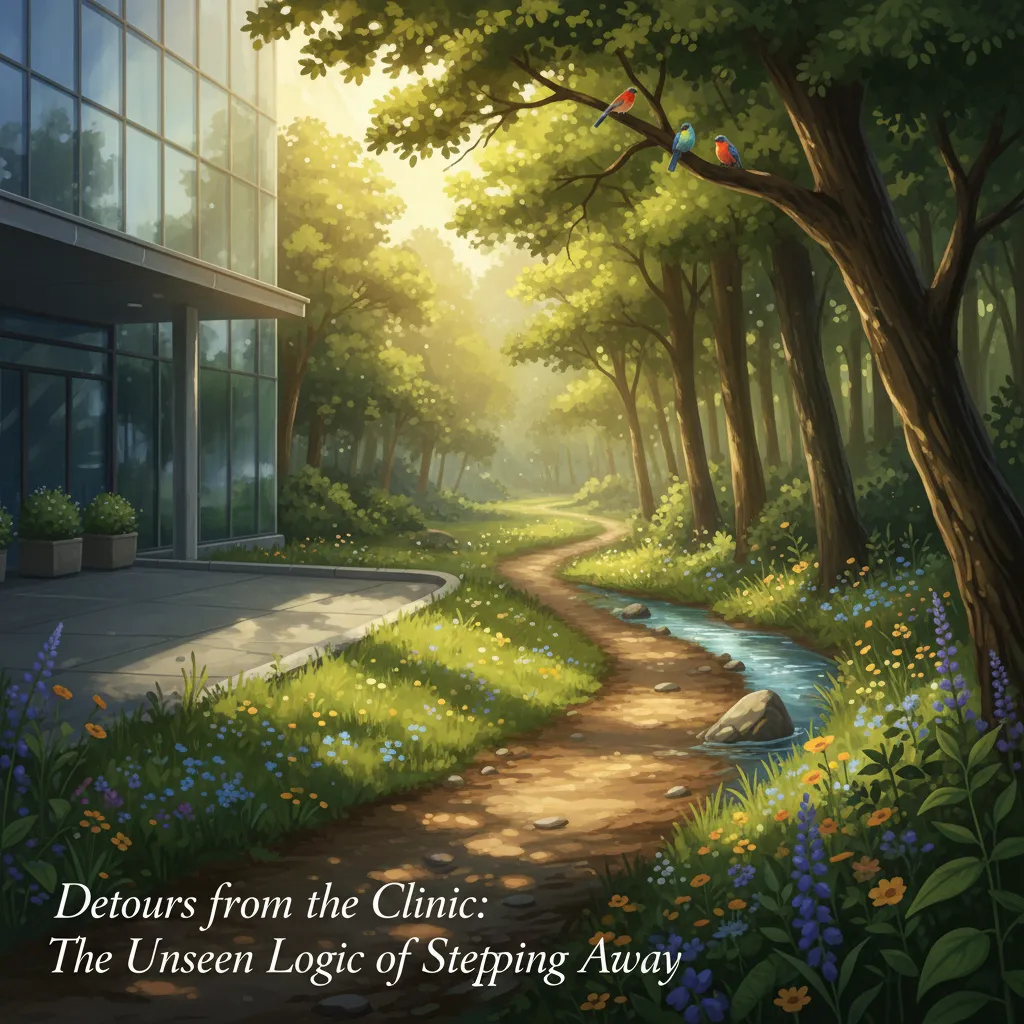In the echoing corridors of hospitals, decisions rarely come with roadmaps. In fact, sometimes they come with nothing but a kettle and a restless mind. Today’s story unpeels what it’s really like to step away from a lifelong medical career—and why, after six months (and a lot of existential tea), some doctors find themselves drawn back into scrubs. It’s not a tidy narrative, but real stories never are. If you’ve ever wondered how anyone could walk away from being a doctor—or what brings them back—grab a chair (and maybe a biscuit). This tale is tangled, but so is life.
Detours from the Clinic: The Unseen Logic of Stepping Away
The journey from medical school to a clinical career rarely follows a straight line. For many young doctors in the UK, a Medical Break is not a sign of rebellion or burnout, but a built-in part of the system—a pause that is as much about logistics as it is about self-discovery. This is the story of one such detour, a path that wound from the lecture halls of Cambridge to the wards of the NHS, and then, quite naturally, to a big pause in 2020.
From Cambridge Lecture Halls to NHS Wards: A Brief Timeline
- 2012-2018: Six years as a medical student at Cambridge University, learning the science and art of medicine.
- 2017: Launch of a YouTube channel in the final year, a side-hustle that would soon become more than just a hobby.
- 2018-2020: Foundation year doctor in East Anglia, UK—rotating through specialties, gaining hands-on experience, and facing the reality of clinical life.
- August 2020: The big pause—a Clinical Break from medicine, planned a year in advance, marking a natural transition point.
Why Leaving Medicine Isn’t Rebellion—It’s Routine
In the UK, the first two years after medical school—known as the Foundation Programme—are designed for exploration. Junior doctors rotate through a range of specialties, from surgery to psychiatry, before making a pivotal decision: which field to pursue long-term. This choice, made a year in advance, can feel impossibly high-stakes. It shapes not only a doctor’s daily work, but also their social circles, lifestyle, and even future relationships.
It’s no wonder, then, that many doctors opt for a Career Gap Strategy after their foundation years. This isn’t about running away from medicine; it’s about buying time to make a thoughtful decision. As one doctor put it, “The thing that you think about in the shower should be the thing that you do with your life.” Taking a Medical Break is a way to figure out what that thing truly is.
Career Uncertainty: The Pressure of Early Choices
The reality is, most doctors began their journey at 16, choosing A-levels and university courses before they’d even finished growing up. By the time they reach their late 20s, the pressure to commit to a specialty can feel overwhelming. The system expects certainty, but life rarely offers it. Many find themselves questioning whether the path they started on still fits who they are becoming.
This uncertainty is not a failure; it’s a sign of growth. Taking a Clinical Break allows doctors to pause, reflect, and explore other interests—without closing the door on medicine forever. In fact, research shows that planning ahead and maintaining professional networks during a gap can make re-entry smoother and less stressful.
Discovery Beyond the Hospital: Side-Hustles and New Passions
For some, stepping away from the clinic opens up unexpected opportunities. The YouTube channel that began as a side project during medical school became a creative outlet—and a potential new career. Others use their gap year to travel, teach, or try research in a different country. The thrill of not being tied to a hospital rota can be both liberating and unnerving.
- Side-hustles: Building skills outside medicine, from content creation to entrepreneurship.
- Teaching: Sharing knowledge with students or peers, discovering a passion for education.
- Travel: Working in hospitals abroad, broadening clinical and cultural horizons.
Sometimes, these detours lead back to medicine with renewed purpose. Other times, they spark a new direction entirely. Either way, the logic of stepping away is clear: flexibility is crucial in Medical Training, and a Physician Career is rarely a straight road.
The thing that you think about in the shower should be the thing that you do with your life.
Parental expectations and societal pressure can make these choices even harder. But as many doctors discover, the courage to take a break—and the wisdom to plan it well—can shape not just a career, but a life.

Lost in Specialties: When Passion Fizzles and New Paths Call
Choosing a medical specialty is one of the most pivotal—and paralyzing—decisions a doctor faces. For many, this choice comes long before they’re truly ready, shaping not just their work, but the entire trajectory of their lives. The pressure to commit is immense, especially when clinical experience is limited and the stakes feel impossibly high. For some, the journey through medical school and early practice becomes less about finding a calling and more about discovering what doesn’t fit.
Uncertainty at the Crossroads: The Weight of Early Decisions
For many aspiring doctors, the decision to pursue medicine is made shockingly early. It’s not uncommon to start building a medical school application at 14 or 15, long before most teenagers have any real sense of the world of work. “I don’t want to be welded to a decision I made at 16,” one doctor reflects, capturing the anxiety that comes with realizing how much rides on a teenage choice. Surrounded by family and friends in medicine, it can feel like the only logical path—especially when other careers are little more than vague ideas.
By the time medical school begins, the pressure only increases. The process of choosing a specialty—whether it’s cardiology, psychiatry, surgery, or something else—can feel like picking a life sentence. Yet, with limited exposure to each field, it’s a decision often made in the dark. The reality is, clinical competence and confidence are closely tied to experience, and gaps in exposure can leave new doctors feeling lost.
When Fulfillment Lies Beyond the Hospital Walls
For some, the realization hits hard: the passion for medicine isn’t as strong as expected. Instead, fulfillment comes from unexpected places. Teaching, coding, and entrepreneurship can spark more joy than hospital rounds ever did. “If I think about what I think about in the shower, it’s never about medicine,” the same doctor admits. It’s a startling moment—one that brings both panic and clarity. The dream of becoming a doctor, shaped in adolescence, suddenly feels out of step with adult passions.
During medical school, side projects like building businesses and designing websites become sources of genuine excitement. Teaching others, too, brings a sense of meaning that clinical work sometimes lacks. These pursuits offer a different kind of purpose, one that isn’t tied to a stethoscope or a white coat. For doctors considering a career transition or even returning to medicine later, these experiences can be just as valuable as time spent on the wards.
Anecdote: The Specialty That Wasn’t
The reality of specialty training can be sobering. Take the example of a doctor who spent four months in obstetrics and gynecology—then, due to the pandemic, another four months in the same department. What began as a possible career path quickly lost its appeal. The daily routines, the cases, even the successes, failed to ignite any real passion. “I kind of fell out of love with it,” they admit, realizing that sometimes, knowing what you don’t want is just as important as knowing what you do.
Exposure to other specialties—cardiology, elderly care, general surgery, psychiatry—didn’t help much. None felt like the right fit. The only field that sparked interest was emergency medicine, but with no real experience in the ER, committing to a seven-year training program felt reckless. This uncertainty is common, and it can leave doctors questioning not just their specialty, but their place in medicine altogether.
When New Paths Call: The Panic and the Pivot
There’s a unique panic in realizing you might not want to be the thing you trained to become. For some, this leads to a break from medicine—a chance to explore other passions, build businesses, or simply breathe. The fear of regret looms large: “I don’t want to look back at my life 30 years from now and think, damn, I regret sticking to that.” For others, it’s about finding a way to return to medicine on their own terms, perhaps in a different specialty, or after gaining new skills and perspectives outside the hospital.
Ultimately, the journey through medical specialties is rarely straightforward. It’s shaped by early decisions, unexpected joys, and the courage to admit when passion has fizzled. Whether leaving, returning to medicine, or forging a new path entirely, the search for fulfillment is ongoing—and deeply personal.

Finding the Way Back: The Not-So-Linear Road to Medical Re-entry
For many, the idea of a doctor stepping away from medicine—especially during a crisis like the pandemic—seems unthinkable. Social media comments often echo the same sentiment: “How can you feel okay with leaving medicine in the middle of a pandemic?” But the reality, especially in the UK, is far more nuanced. Most doctors who took career breaks around this time had made their decisions long before COVID-19 was even a headline. The UK medical training system is structured so that career breaks are not abrupt walkouts, but rather natural pauses built into the journey. Doctors apply for specialty training a year in advance, and many choose to take a gap before committing, often without knowing what the future holds.
This planned pause is not just a UK phenomenon, but it’s particularly visible there. The average time away before formal medical re-entry is about 2.8 years. During this time, doctors might travel, explore other interests, or simply take a breath after years of relentless training. As one doctor reflected,
“It makes sense to take a step back and actually think: What do I actually want to do?”This moment of reflection is rarely about abandoning medicine, but about finding clarity and perspective.
Yet, returning to medicine is rarely a straight line. The path back is layered with logistics, emotions, and a maze of requirements. Medical re-entry is shaped by more than just personal readiness; it is also about navigating re-entry programs, licensure requirements, and the ever-present need for continuing education. In the UK, resources like SuppoRTT (Supported Return to Training) offer tailored support, including mentoring, simulation training, and practice-based learning. In the US, the American Medical Association and various state boards provide guidance, but the requirements can vary widely. Some re-entry programs cost between $10,000 and $20,000 or more, and may involve assessments, supervised practice, and proof of ongoing education.
These hurdles are not just bureaucratic. They can stir up lingering doubts: Am I still competent? Will my colleagues accept me back? Is this really what I want? The process can feel daunting, especially when the professional network that once felt so familiar now seems distant. Yet, these challenges also serve as a filter, ensuring that those who return do so with renewed commitment and up-to-date skills.
One often overlooked benefit of stepping out is the perspective gained. Time away from the white coat can broaden horizons, spark creativity, and even reignite the passion that first drew someone to medicine. Some doctors use this time to travel, pursue creative projects, or simply rest—luxuries rarely afforded during training. Thanks to alternative income streams, like a successful YouTube channel or other ventures, some are able to explore these options without immediate financial pressure. This break can be a source of strength, not weakness, and can lead to a more balanced, resilient return.
Still, the process is far from perfect. The logistics of medical re-entry—navigating licensure requirements, finding the right re-entry program, and staying current with continuing education—can be overwhelming. But support is growing. Programs like SuppoRTT in the UK and various re-entry pathways in the US are evolving to meet the needs of returning physicians, recognizing that a career in medicine is rarely a straight path.
Perhaps it’s time to rethink the narrative. What if doctors, like musicians or academics, took career sabbaticals as a norm? What if stepping away was seen not as a failure or abandonment, but as a healthy, even necessary, part of a lifelong career? The truth is, the road to medical re-entry is not linear. It is shaped by personal growth, logistical hurdles, and a changing profession. But for those who choose to return, the journey back can be just as meaningful—and transformative—as the journey out.
TL;DR: Stepping away from medicine isn’t always a simple exit—it’s often a pause, predicated on self-doubt, shifting dreams, and a need to recenter. For many, returning is less about duty and more about rediscovering a sense of purpose through the chaos.



